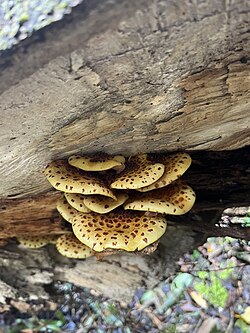Biology:Pholiota glutinosa
| Pholiota glutinosa | |
|---|---|

| |
| Scientific classification | |
| Domain: | Eukaryota |
| Kingdom: | Fungi |
| Division: | Basidiomycota |
| Class: | Agaricomycetes |
| Order: | Agaricales |
| Family: | Strophariaceae |
| Genus: | Pholiota |
| Species: | P. glutinosa
|
| Binomial name | |
| Pholiota glutinosa (Massee) E. Horak (1971)[1]
| |
Pholiota glutinosa is a species of poisonous fungi in the genus Pholiota, endemic to New Zealand.
Taxonomy
First discovered by George Edward Massee in 1989 where it was originally named Hypholoma glutinosum.[2][3] It has also been named P. adiposa and P. aurivellaas..[4]
Description
This species produces its fruit body from Autumn to early Winter.[4] The pileus is convex and obtuse, ranging from 40-60mm in diameter and 60-80mm in height. The pileus is yellow with concentrically arranged evanescent darker squarrose scales 5-12mm across. The pileus is shiny in dry weather due to the dried gluten layer on its surface. In wet conditions, the scales dissolve into the surface gluten. The flesh is white. Gills adnate and range from 6-8mm long. The spores are rusty orange, elliptical in shape with an area of 7 x 3 µm. The stem is 7-12cm long and can be up to 2cm thick.[5]
Pholiota glutinosa is poisonous.[5]
Habitat and distribution
Pholiota glutinosa is found on decaying wood and trees. Distribution is all over New Zealand, also found in Europe and the United States.[5]
Etymology
glutinosa: From the Greek gloeo ‘glue’, refers to the shiny pileus due to gluten present on its surface, giving it a shiny appearance.[6]
See also
References
- ↑ "Pholiota glutinosa (Massee) E.Horak" (in en). https://www.gbif.org/species/2534201.
- ↑ Horak, E. (September 1971). "A contribution towards the revision of the Agaricales (fungi) from New Zealand". New Zealand Journal of Botany 9 (3): 402–462. doi:10.1080/0028825x.1971.10430193. ISSN 0028-825X. http://dx.doi.org/10.1080/0028825x.1971.10430193.
- ↑ "Hypholoma glutinosum Massee" (in en). https://www.gbif.org/species/2534202.
- ↑ 5.0 5.1 5.2 "Pholiota glutinosa (Massee) E. Horak 1971 - Biota of NZ". https://biotanz.landcareresearch.co.nz/scientific-names/1cb1b610-36b9-11d5-9548-00d0592d548c.
- ↑ "Pholiota glutinosa" (in en). https://www.nzpcn.org.nz/flora/species/pholiota-glutinosa/.
External links
Wikidata ☰ Q10628048 entry
 |

